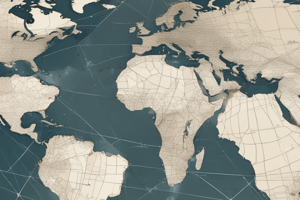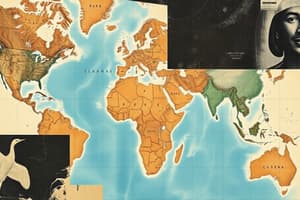Podcast
Questions and Answers
What is the angular distance of a point on the Earth's surface from the equator?
What is the angular distance of a point on the Earth's surface from the equator?
- Longitude
- Latitude (correct)
- Altitude
- Elevation
What is the latitude of the Tropic of Cancer?
What is the latitude of the Tropic of Cancer?
- 20° N
- 40° N
- 23.5° N (correct)
- 30° N
What is the purpose of the International Date Line?
What is the purpose of the International Date Line?
- To mark the Prime Meridian
- To separate two consecutive calendar days (correct)
- To separate the Northern and Southern Hemispheres
- To mark the equator
How are latitude and longitude coordinates typically written?
How are latitude and longitude coordinates typically written?
What is the significance of latitude in terms of climate and weather patterns?
What is the significance of latitude in terms of climate and weather patterns?
What is the purpose of longitude in terms of time zones?
What is the purpose of longitude in terms of time zones?
Flashcards are hidden until you start studying
Study Notes
Latitude and Longitude
Definition
- Latitude: The angular distance of a point on the Earth's surface from the equator, measured in degrees, minutes, and seconds.
- Longitude: The angular distance of a point on the Earth's surface from the Prime Meridian, measured in degrees, minutes, and seconds.
Key Concepts
- Latitude Ranges:
- Equator: 0° latitude
- Tropic of Cancer: 23.5° N latitude
- Tropic of Capricorn: 23.5° S latitude
- Arctic Circle: 66.5° N latitude
- Antarctic Circle: 66.5° S latitude
- Longitude Ranges:
- Prime Meridian: 0° longitude (passes through Greenwich, England)
- International Date Line: 180° longitude (separates two consecutive calendar days)
Measuring Latitude and Longitude
- Degrees, Minutes, and Seconds:
- 1 degree = 60 minutes
- 1 minute = 60 seconds
- Latitude and Longitude Coordinates:
- Written in the format: latitude, longitude (e.g., 37.7749° N, 122.4194° W)
- Can be expressed in decimal degrees (e.g., 37.7749, -122.4194)
Importance of Latitude and Longitude
- ** Navigation and Mapping**: Essential for navigation, mapping, and geographic information systems (GIS)
- Climate and Weather: Latitude affects climate and weather patterns, with latitudes near the equator receiving more direct sunlight
- Time Zones: Longitude is used to determine time zones, with each zone representing a one-hour difference from UTC (Coordinated Universal Time)
Latitude and Longitude
Definitions
- Latitude is the angular distance of a point on the Earth's surface from the equator, measured in degrees, minutes, and seconds.
- Longitude is the angular distance of a point on the Earth's surface from the Prime Meridian, measured in degrees, minutes, and seconds.
Key Concepts
Latitude
- The equator is at 0° latitude.
- The Tropic of Cancer is at 23.5° N latitude.
- The Tropic of Capricorn is at 23.5° S latitude.
- The Arctic Circle is at 66.5° N latitude.
- The Antarctic Circle is at 66.5° S latitude.
Longitude
- The Prime Meridian is at 0° longitude, passing through Greenwich, England.
- The International Date Line is at 180° longitude, separating two consecutive calendar days.
Measuring Latitude and Longitude
- 1 degree is equal to 60 minutes.
- 1 minute is equal to 60 seconds.
- Latitude and longitude coordinates are written in the format: latitude, longitude (e.g., 37.7749° N, 122.4194° W).
- Latitude and longitude coordinates can be expressed in decimal degrees (e.g., 37.7749, -122.4194).
Importance of Latitude and Longitude
- Latitude and longitude are essential for navigation, mapping, and geographic information systems (GIS).
- Latitude affects climate and weather patterns, with latitudes near the equator receiving more direct sunlight.
- Longitude is used to determine time zones, with each zone representing a one-hour difference from UTC (Coordinated Universal Time).
Studying That Suits You
Use AI to generate personalized quizzes and flashcards to suit your learning preferences.




